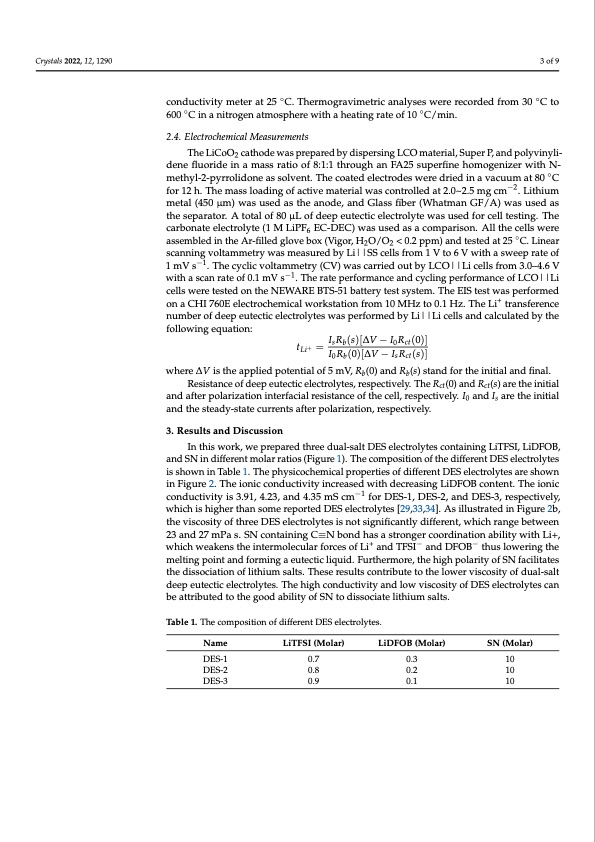
PDF Publication Title:
Text from PDF Page: 003
Crystals 2022, 12, 1290 3 of 9 conductivity meter at 25 ◦C. Thermogravimetric analyses were recorded from 30 ◦C to 600 ◦C in a nitrogen atmosphere with a heating rate of 10 ◦C/min. 2.4. Electrochemical Measurements The LiCoO2 cathode was prepared by dispersing LCO material, Super P, and polyvinyli- dene fluoride in a mass ratio of 8:1:1 through an FA25 superfine homogenizer with N- methyl-2-pyrrolidone as solvent. The coated electrodes were dried in a vacuum at 80 ◦C for 12 h. The mass loading of active material was controlled at 2.0~2.5 mg cm−2. Lithium metal (450 μm) was used as the anode, and Glass fiber (Whatman GF/A) was used as the separator. A total of 80 μL of deep eutectic electrolyte was used for cell testing. The carbonate electrolyte (1 M LiPF6 EC-DEC) was used as a comparison. All the cells were assembled in the Ar-filled glove box (Vigor, H2O/O2 < 0.2 ppm) and tested at 25 ◦C. Linear scanning voltammetry was measured by Li||SS cells from 1 V to 6 V with a sweep rate of 1 mV s−1. The cyclic voltammetry (CV) was carried out by LCO||Li cells from 3.0–4.6 V with a scan rate of 0.1 mV s−1. The rate performance and cycling performance of LCO||Li cells were tested on the NEWARE BTS-51 battery test system. The EIS test was performed on a CHI 760E electrochemical workstation from 10 MHz to 0.1 Hz. The Li+ transference number of deep eutectic electrolytes was performed by Li||Li cells and calculated by the following equation: tLi+ = IsRb(s)[∆V − I0Rct(0)] I0Rb(0)[∆V − IsRct(s)] where ∆V is the applied potential of 5 mV, Rb(0) and Rb(s) stand for the initial and final. Resistance of deep eutectic electrolytes, respectively. The Rct(0) and Rct(s) are the initial and after polarization interfacial resistance of the cell, respectively. I0 and Is are the initial and the steady-state currents after polarization, respectively. 3. Results and Discussion In this work, we prepared three dual-salt DES electrolytes containing LiTFSI, LiDFOB, and SN in different molar ratios (Figure 1). The composition of the different DES electrolytes is shown in Table 1. The physicochemical properties of different DES electrolytes are shown in Figure 2. The ionic conductivity increased with decreasing LiDFOB content. The ionic conductivity is 3.91, 4.23, and 4.35 mS cm−1 for DES-1, DES-2, and DES-3, respectively, which is higher than some reported DES electrolytes [29,33,34]. As illustrated in Figure 2b, the viscosity of three DES electrolytes is not significantly different, which range between 23 and 27 mPa s. SN containing C≡N bond has a stronger coordination ability with Li+, which weakens the intermolecular forces of Li+ and TFSI− and DFOB− thus lowering the melting point and forming a eutectic liquid. Furthermore, the high polarity of SN facilitates the dissociation of lithium salts. These results contribute to the lower viscosity of dual-salt deep eutectic electrolytes. The high conductivity and low viscosity of DES electrolytes can be attributed to the good ability of SN to dissociate lithium salts. Table 1. The composition of different DES electrolytes. Name DES-1 DES-2 DES-3 LiTFSI (Molar) 0.7 0.8 0.9 LiDFOB (Molar) 0.3 0.2 0.1 SN (Molar) 10 10 10PDF Image | Non-Flammable Dual-Salt Deep Eutectic Electrolyte

PDF Search Title:
Non-Flammable Dual-Salt Deep Eutectic ElectrolyteOriginal File Name Searched:
crystals-12-01290-v2.pdfDIY PDF Search: Google It | Yahoo | Bing
Product and Development Focus for Salgenx
Redox Flow Battery Technology: With the advent of the new USA tax credits for producing and selling batteries ($35/kW) we are focussing on a simple flow battery using shipping containers as the modular electrolyte storage units with tax credits up to $140,000 per system. Our main focus is on the salt battery. This battery can be used for both thermal and electrical storage applications. We call it the Cogeneration Battery or Cogen Battery. One project is converting salt (brine) based water conditioners to simultaneously produce power. In addition, there are many opportunities to extract Lithium from brine (salt lakes, groundwater, and producer water).Salt water or brine are huge sources for lithium. Most of the worlds lithium is acquired from a brine source. It's even in seawater in a low concentration. Brine is also a byproduct of huge powerplants, which can now use that as an electrolyte and a huge flow battery (which allows storage at the source).We welcome any business and equipment inquiries, as well as licensing our flow battery manufacturing.| CONTACT TEL: 608-238-6001 Email: greg@salgenx.com | RSS | AMP |